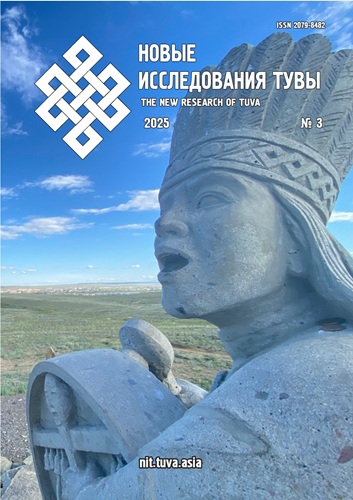Фонетическая вариативность татарских антропотопонимов в топонимии Западно-Сибирского ареала
DOI:
https://doi.org/10.25178/nit.2025.3.28Ключевые слова:
татарский язык; диалект; антропотопоним; татарская топонимика; фонетикаАннотация
В исследовании рассматриваются фонетические особенности татарских антропотопонимов Западно-Сибирского ареала (Тюменская, Новосибирская и Кемеровская области). Работа направлена на выявление специфики и закономерностей фонетического варьирования данных наименований, определение основных типов звуковых изменений и факторов, влияющих на появление их вариантов.
В ходе полевых экспедиций в места компактного проживания татар на территории указанных областей было собрано 250 единиц лексем-антропотопонимов. Осуществлялся сравнительный анализ рассматриваемых терминов и топонимов с их аналогами в других диалектах татарского языка, а также в родственных тюркских языках.
Анализ выявил преобладающее количество лексем арабо-персидского происхождения (более 60%) и значительную долю тюркских этимонов (более 20%). Доля заимствований из русского языка составила существенно меньший процент (7%). Оставшиеся 5% антропотопонимов требуют дополнительного этимологического анализа.
Выявлено, что наиболее частотным фонетическим процессам являются оглушение звонких согласных в начальной и конечной позициях, чередования /ɕ/ /t͡s/, /ʒ/ /t͡ɕ/, /q/k/ /х/, а также выпадение нехарактерных для исконной фонетической системы звуков /h/, /ʁ/.
С одной стороны, фонетическая составляющая антропотопонимов восточного диалекта сохраняет архаичные черты, восходящие к древнетюркскому состоянию, и демонстрирует явления с ограниченным ареалом распространения в тюркской семье, обнаруживая сходства с алтайско-хакасской подгруппой. С другой стороны, в ней присутствуют признаки, характерные для кыпчакских языков.
Библиографические ссылки
Баскаков, Н. А. (1940) Ногайский язык и его диалекты. М. ; Л. : Изд-во АН СССР. 272 с.
Дмитриев, Н. К. (1955) Фонетические закономерности начала и конца тюркского слова // Исследования по сравнительной грамматике тюркских языков : в 4-х ч. / под общ. ред. Н. К. Дмитриева. М. : АН СССР. Ч. I. Фонетика. 336 с. С. 265–273.
Никонов, В. А. (1965) Введение в топонимику. М. : Наука. 179 с.
Саттаров, Г. Ф. (1973) Татарстан АССРның антропотопонимнары. [Антропотопонимы Татарской АССР]. Казан : КДУ. 269 б. (На татар. яз.)
Сувандии, Н. Д. (2021) Антропонимы тувинского языка, связанные с буддийской религией // Новые исследования Тувы. № 2. С. 44–51. DOI: https://doi.org/10.25178/nit.2021.2.4
Сувандии, Н. Д. (2023) Чер ‘земля’ в паремиях тувинцев // Новые исследования Тувы. № 1. С. 26–37. DOI: https://doi.org/10.25178/nit.2023.1.2
Тумашева, Д. Г. (1977) Диалекты сибирских татар. Казань : Казан. гос. ун-т. 293 с.
Хадиева, Г. К. (2016) Антропоойконимы Татарстана (по материалам писцовых книг XVI–XVII вв.) // Ономастика Поволжья: материалы Международной научной конференции (Арзамас, 13–16 сентября 2016 г.) / под ред. Л. А. Климковой, В. И. Супруна. Арзамас ; Саров : Интерконтакт. 529 с. С. 232–236.
Опубликован
Как цитировать
For citation:
Khisamov O. R., Khalikov I. I. and Khusainova A. Ya. Phonetic Variability of Tatar Аnthropotoponyms in the Toponymy of the West Siberian Area. New Research of Tuva, 2025, no. 3, pp. 459-468. DOI: https://doi.org/10.25178/nit.2025.3.28
Выпуск
Раздел

Это произведение доступно по лицензии Creative Commons «Attribution-NonCommercial» («Атрибуция — Некоммерческое использование») 4.0 Всемирная.

Автор (лицензиар) произведения предоставляет простую (неисключительную) лицензию на использование редакцией (лицензиатом) произведения науки, который заключается в упрощённом порядке (открытая лицензия), согласно ст. 1286.1. «Открытая лицензия на использование произведения науки, литературы или искусства» Гражданского кодекса Российской Федерации.
В нашем издании публикуемые материалы доступны по лицензии Creative Commons «Attribution-NonCommercial» («Атрибуция — Некоммерческое использование») — CC BY-NC.
Т. к. лицензия открытая, автор имеет право разместить статью после ее выхода на своем сайте, читатель может скопировать и разместить на своих персональных ресурсах, в том числе в виде выдержек, конспектов, но:
а) обязательно должно быть указано ФИО автора, неизмененное название статьи и гиперссылка на первоисточник (журнал «Новые исследования Тувы»),
б) размещающий не имеет права брать деньги за доступ к этому материалу или каким бы то ни было образом давать преимущество одним читателям над другими,
в) при перепечатке автором текста статьи без значительных изменений (если сохраняется 30% текста или более) должно быть указано, что первая редакция статьи вышла в журнале «Новые исследования Тувы» и сделана соответствующая ссылка.
Лицензия действует по всему миру, длится в течение срока авторских прав на произведение, является неотзывной.











